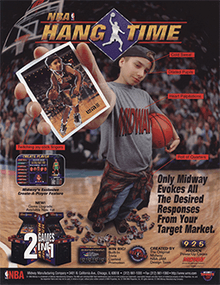NBA Hangtime
| NBA Hangtime | |
|---|---|
 Arcade flyer for NBA Hangtime | |
| Developer(s) | Midway |
| Publisher(s) | Midway |
| Platform(s) | Arcade, Nintendo 64, PlayStation, Sega Genesis, Super NES, Windows |
| Release date(s) |
Arcade
Nintendo 64 PlayStation
Super NES
Sega Genesis Windows
|
| Genre(s) | Sports |
| Mode(s) | Single player, multiplayer |
NBA Hangtime is a basketball video game developed and published by Midway and released for arcade in 1996. Home versions followed for Nintendo 64, PlayStation, Sega Mega Drive/Genesis, Super NES, and Microsoft Windows. A version for Game.com was cancelled.
Hangtime was the third basketball game by the original development team behind the NBA Jam series. The title was changed due to the NBA Jam name being acquired by Acclaim Entertainment, the publisher of the games for the home market. Acclaim's NBA Jam Extreme was released the same year as Hangtime. Features introduced in Hangtime included character creation, alley oops and double dunks. A software update known as NBA Maximum Hangtime was released for the arcades later in the life cycle. A sequel, NBA Showtime: NBA on NBC, was released in 1999.
Gameplay
The gameplay is largely the same as the Midway's NBA Jam games, with some additions. One of the most prominent additions is the "Create Player" feature, which allows players to create a custom basketball player, specifying height, weight, power, shooting and defensive skills using a limited number of attribute points. Created players can be made more powerful as players earn additional attribute points by winning games.
The game retains many of the same rules of NBA Jam Tournament Edition, including the two-on-two match ups, statistics tracking, legal pushing and "on fire" mode. Additions to the gameplay include spin moves, alley oops and double slam dunks - a slam dunk performed after one team member in the middle of a dunk passes to the other member. Alley-oops and double dunks can trigger the new "team fire" mode in which both team members are on fire.
Each team now has five members of the roster to choose from. The original arcade version features team rosters from the 1995-96 NBA season, while the home console versions feature team rosters that were accurate to the 1996-97 NBA season. The player can select from any of the 29 NBA teams and match them in four quarters of NBA basketball (three minutes each), with three-minute overtimes if necessary. Just as in the NBA Jam games, the game can keep track of the teams a player has beaten using a player's created ID and PIN. Optionally, the player can load their created player. Players using their ID face off against a series of NBA teams, starting with the Vancouver Grizzlies and ending with the Chicago Bulls (who were on their way to being NBA champions at the time of the game's release). After beating all 29 teams, the player faces off against a number of secret characters.
New to the game is a three-digit "combination lock" feature. Similar to the "Kombat Kodes" in Mortal Kombat 3, the feature allows players to enter codes on the Match Up screen that alter the game's appearance and/or gameplay.
The initial arcade version and the home versions included an NBA trivia quiz at the end of each game played. Answering enough trivia questions correctly in the arcade game originally qualified players for a prize drawing, while on home versions it gives players more attribute points for their created players.
Music
The theme song "Whatcha Gonna Do?" and "Get Up, Get Up (First Quarter music)" were produced by rapper M-Doc of Indasoul.
Reception
Computer and Video Games dubbed Hangtime "the real, and quite worthy, successor to NBA Jam TE". The graphics improvements were lauded, as were the new features, moves and the created player feature.[1] The home ports received mixed reviews. Doug Perry of IGN, writing about the Nintendo 64 version also praised the create a player feature calling it "easily one of the coolest elements of the game, and separates it from the pack." Perry wrote that the port didn't make much use of the N64's capabilities, but called it a "fun, arcade-perfect port that will bring most basketball fans lots (sic) enjoyment."[2] GameSpot was far more negative, with Jeff Gerstmann reviewing the N64 version and writing that the game only featured "minor changes" and concluding "Unless you've been shooting digital hoops in a cave for the past few years, you've seen it all before." He scored the game a 5.4 out of 10.[3] The PlayStation version was also criticized for its long loading times.[4] Kraig Kujawa was far more positive about the PC version, scoring it a 7.2 out of 10 and saying that it was an accurate conversion, although lamenting that it didn't include online play.[5]
Maximum Hangtime
NBA Maximum Hangtime is an upgrade to the arcade version of NBA Hangtime featuring 1996-1997 NBA rosters. Otherwise, the gameplay is essentially the same except for the addition of a hidden "hot spot" on the court for each player where they shoot more accurately. "Maximum" also has some additional secret codes and hidden players.[6]
References
- ↑ "NBA Hangtime". Computer and Video Games: 12. 1996. Retrieved June 24, 2012.
- ↑ Perry, Doug (January 27, 1997). "NBA Hang Time review". IGN. Retrieved June 24, 2012.
- ↑ Gerstmann, Jeff (December 9, 1996). "NBA Hangtime Review". GameSpot. Retrieved June 24, 2012.
- ↑ Lehrman, Daniel (June 13, 1997). "NBA Hangtime Review". GameSpot. Retrieved June 24, 2012.
- ↑ Kujawa, Kurt (February 14, 1997). "NBA Hangtime Review". GameSpot. Retrieved June 24, 2012.
- ↑ "Dan's Mostly Maximum Hangtime Shrine". Bunnyears.net. 2003-01-11. Retrieved 2012-10-18.